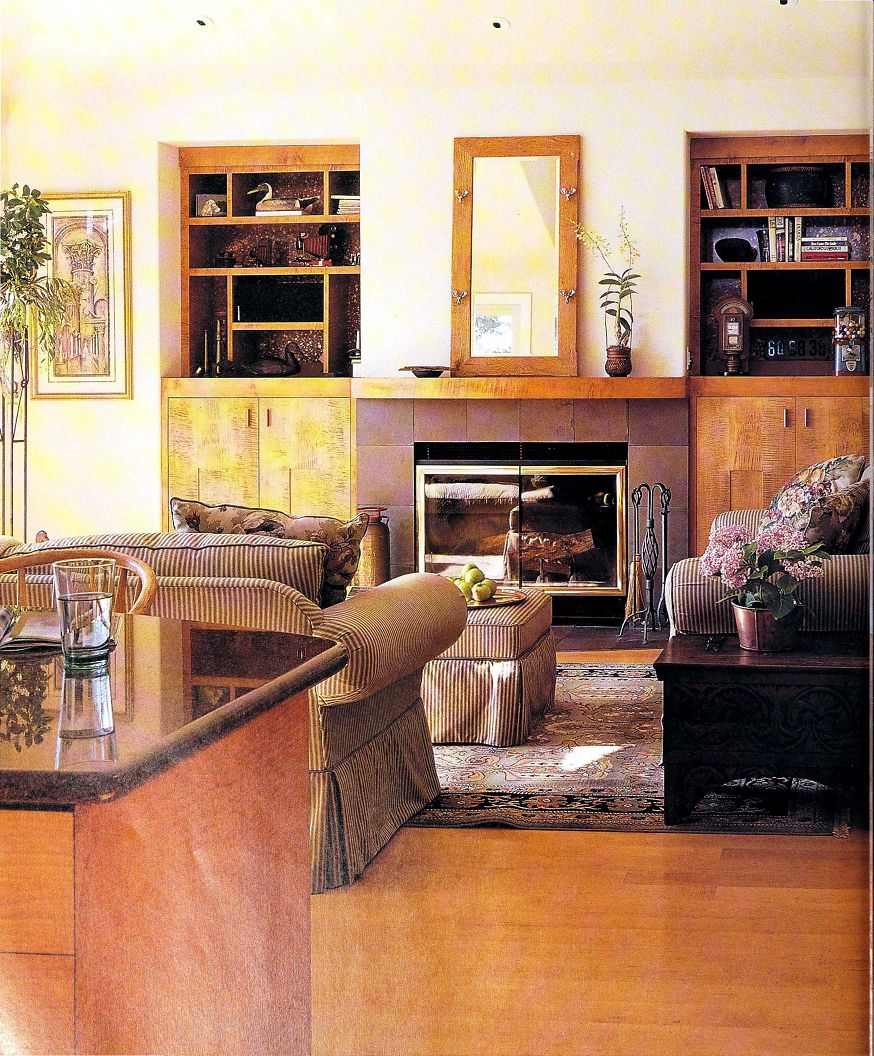
--------------- This room has a lived-in, welcoming feel, yet the less appealing paraphernalia of daily life is kept at bay in smart-and attractive-storage. The fireplace acts as an anchor for two built-in storage units; the base cabinet of the right unit conceals clutter, while the base cabinet on the left holds the television. Bookshelves above provide a storage/display area for artful items, as does the fireplace mantel. The end table between couch and love seat offers temporary storage for drinks and a permanent home for a plant.
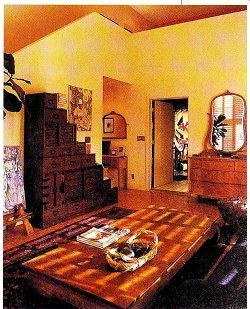
------------- This stepped tansu, a traditional Japanese storage unit,
accommodates the everyday stuff that would otherwise clutter this living room.
Its steps also offer graduated storage display space.
Even more so than the kitchen, today's living space must be a Jack-of-all-trades. Whether we call it a family room, great room, or simply a living room (does anyone say parlor anymore?) , living space is where people go to relax--alone, with family, or with guests. The room must accommodate a variety of activities, from reading the newspaper to watching the World Series, from having a quiet conversation to throwing an elegant party. This contrast of purpose presents a storage challenge. How do you store all the gear related to both entertaining and relaxing without overpowering a space that depends on its looks? Larger houses may be able to afford the space for spin-off living areas that host more specific functions, such as a sitting room or media room, but most living spaces must handle a range of solo and group activities all on their own .
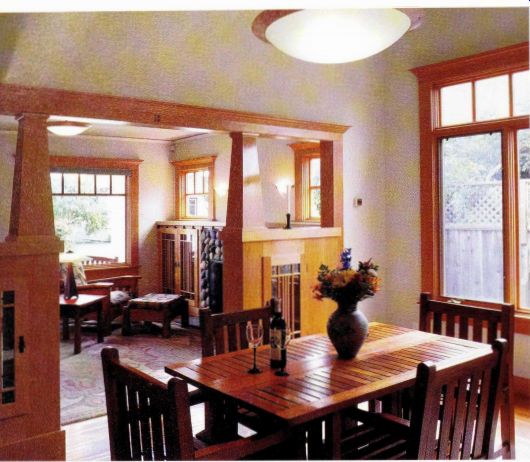
-------------- These Craftsman-style cabinets, in a nontraditional maple,
brighten this bungalow's sitting-room addition. Ha lf-height walls are topped
with stout columns and fitted with display cases that are protected by decorative
glazed doors. These walls separate the sitting and dining rooms without screening
views and light.
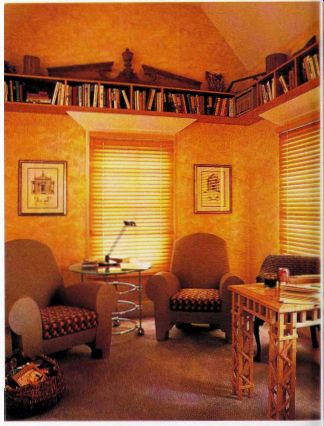
-------------- A double row of books and building artifacts runs around
the room on a high rail, which balances the high ceilings, making the room
more intimate. Baskets and funky tables provide additional storage for books
and other items.
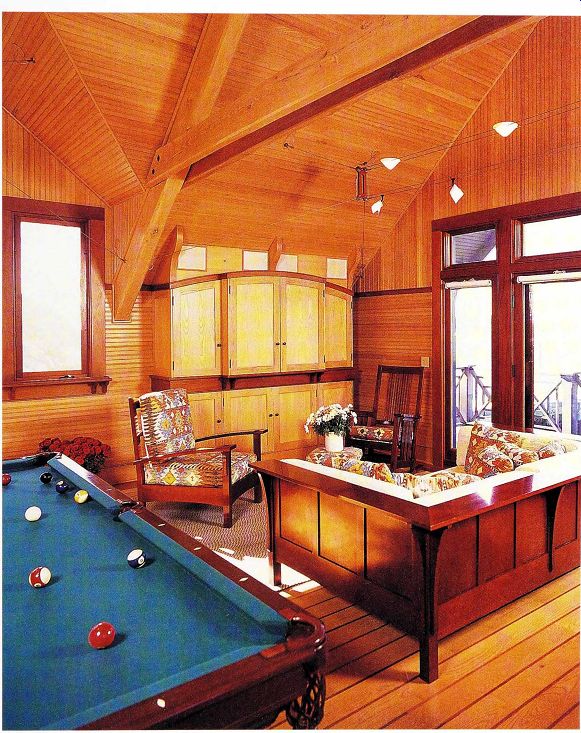
---------- Handsome, arch-topped cabinetry in this well-used family room
is home to all kinds of storage, including games, magazines, a sound system,
mini-kitchen with refrigerator, trash receptacle and dishware storage.
Storage pieces, whether freestanding or built-in, can help organize living space so that it's better able to serve these multiple functions. Along with providing much needed storage space, freestanding and built-in furniture can be used to divide a living space into smaller components that can become more specialized. For instance, a large bookshelf, placed perpendicular to a wall, could partition off a computer desk from the living room where sofas and TV reside.
Freestanding furniture, such as armoires, chests, and tables, can subdivide a living space in less time and for less money than built-in pieces. Many of the living spaces featured in this section use furniture to carve up space while built-in cabinetry is limited to the room's perimeter. Built-in units, however, can be customized to your exact specifications, and personalized storage solutions pave the way for a truly organized home because they take into account your family's particular needs and habits.
Regardless of how you set up living space, it's essential to provide concealed storage to prevent clutter--the alternative is a coffee table that's buried under remote controls and a week's supply of newspapers. Concealed storage is also the likely harbor for a television and sound system plus all the accessories they require. Whether you decide to use freestanding, built-in, or modular units in your living space, make sure the pieces have plenty of drawers or shelves with doors.
Along with closed storage for the things you don't want to see, living rooms should have ample di play space for the things you do, like photographs, artwork, and collections.
=======
Refreshment Center
If your living space isn't immediately adjacent to the kitchen, guests and family alike will appreciate a side table or cabinet dedicated to refreshment. An under-counter refrigerator (which can be paneled or tucked into a cabinet for aesthetics) holds soft drinks, mixers, and party drinks, while shelves provide storage for dishes and glassware. Drawers hold cocktail napkins or coasters, and the flat surface on top of the unit offers a place to set down a drink at a crowded party or a place for hors d'oeuvres.
For quieter family affairs, the unit provides easy access to refills without pausing the movie or missing the winning touchdown.
=========
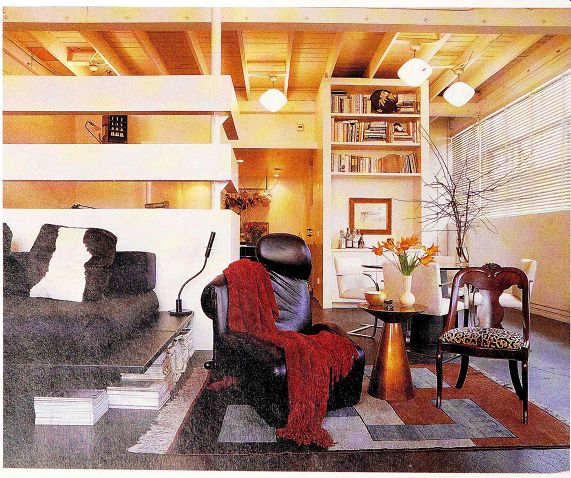
------------- Loft living: The raised bed/couch provides great storage
for magazines underneath. Tall sculptural frames play many roles, acting as
headboard, screening part of the kitchen, and stretching to make bookcases
and a sideboard near the dining table.
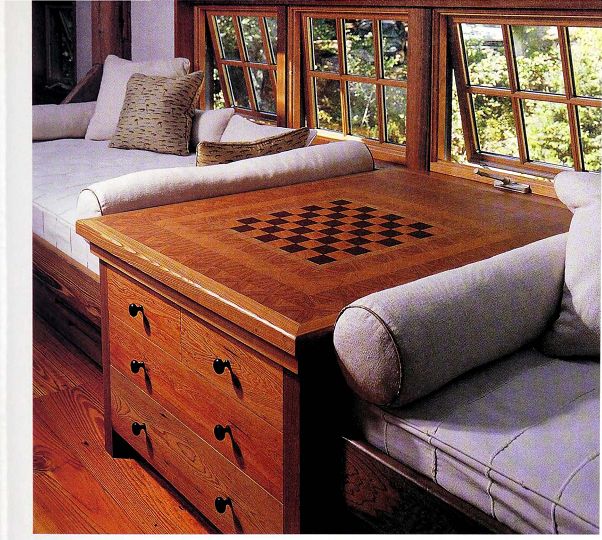
------------ A living room in a Martha's Vineyard house doubles as a
guest bedroom, with bolstered daybeds that also serve as couches. The storage
chest can be a chessboard by day and bedside table by night, while the drawers
hold chess pieces and additional board games.
Freestanding Storage
Built-in storage can take up a substantial amount of space, as well as take a whopping bite from your budget.
And rightly so-it's an investment that will last. Freestanding furniture, on the other hand, offers instant gratification. It can be a less expensive , less permanent option that can be just as useful and dramatic as built-in furniture. As styles and needs change, freestanding furniture can be replaced and moved around, offering more flexibility and possibility. Armoires, hutches, bookcases, tables, trunks, and modular storage systems can be pushed from corner to corner, room to room, reshaping space as need dictates-and it can be carted right out of the house when you move.
While there's no exact combination of freestanding pieces that will guarantee smart storage, it's useful to have a range of storage options. Whatever pieces you choose, you'll have the most flexibility if you give yourself different types of storage-open and closed, shelves and drawers. An end table with a drawer provides a flat surface for drinks and a place for coasters, while a small chest with shelves and doors serves as a miniature wet bar. An armoire houses videos, DVDs, and CDs, while an antique seaman's trunk offers visual interest, as well as a home for extra blankets.
Open shelves mounted at eye level safely display photographs and an.
Cabinets and Beyond
Freestanding cabinets, hutches, armoires, and chests provide a wealth of storage options. Whether antique or in keeping with the latest trends, this category of furniture can be found in nearly every style, size, and price range. Consider how much of each storage type you need, and select pieces that speak to your sense of style and living habits, If you have small children, you'll probably need to focus on closed storage units; if the living space is also a play space, make sure that any tall, freestanding furniture is sturdy enough to withstand an onslaught of tumbling kids. If, however, your house is chi ld-free, a unit with glass doors might be just the thing to show off a collection while protecting it from the elements. It's also important to choose pieces that complement the overall feel of a room. A towering, dark-wood armoire may be overpowering in an informal living space.
Older pieces of furniture, such as an inherited, heart-pine armoire or a black-walnut tansu discovered at an antique shop, can be retrofitted with stronger shelves and modern hardware to make them more sturdy and functional. But don't make such drastic changes to an antique cabinet that has real value to a collector or to your family. A better option may be to purchase fully modernized furniture rendered in a period style.
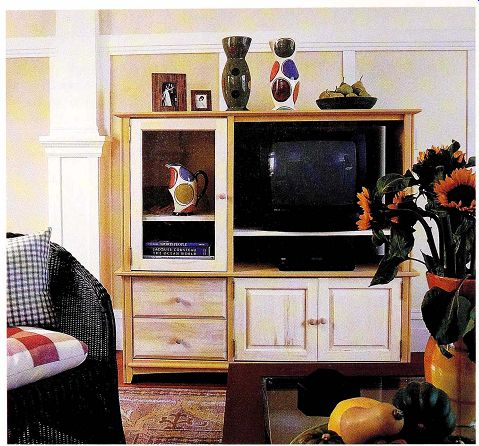
---------- An efficient piece of custom-built furniture holds a television,
VCR, shelves of tapes, and decorative objects. The color scheme of light panels
and darker trim reverses the paint scheme of white trim and darker wall panels.
Modular Storage Components
A popular and affordable way to customize living-room storage is with modular storage systems, now widely available from houseware companies. Modular storage systems have been around for a while, usually with modern styling.
Today's modular storage systems can be found in a number of styles and materials, including wire, metal, and panel products (plywood, medium density fiberboard, and particleboard). These systems can be attached to a wall, but they're generally freestanding.
Modular units are touted for their variety and flexibility: You can plug together shelves, cubbies, and drawers at will and change them as needs change. They're a great storage option for growing families, where toddlers' toys will make way for older kids' toys, such as board games, video games, and music.
While many of us will never change our storage units once they're in place, it's comforting to know that we can easily swap a drawer for a shelf or three shelves for two. This versatility of design and the relative ease of installation make modular storage an ever-popular solution to our ever-growing collection of stuff.
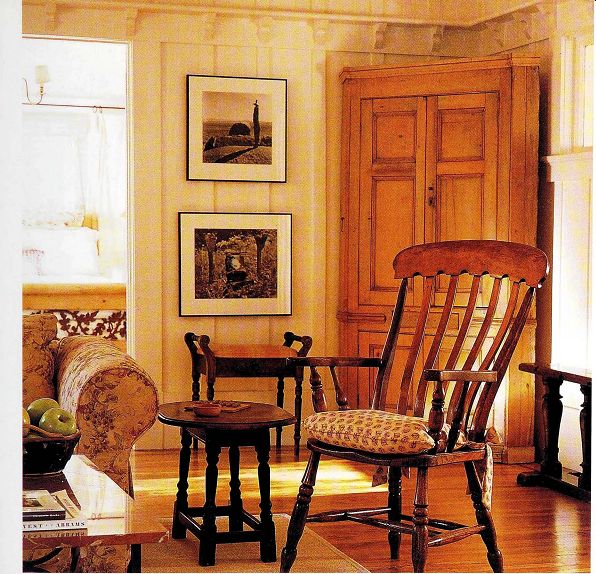
---------- Floor Outlets
For furniture placed against walls, it's easy to find outlets for electronic equipment and lighting. But a more comfortable, versatile living space is likely to have furniture placed away from the wall to make separate conversation and activity areas, so consider floor outlets (it's dangerous to cover electrical cords with carpets). You can custom-cut to handle the outlet and its brass plate, or simply position area rugs to avoid the floor outlet. A handsome, antique corner cupboard finds a new home in this charming, buttery living room. It provides the perfect hiding place for modern conveniences, such as a television or sound system.
Tables
Tables are essential storage elements in a living room, primarily for short-term storage of games, reading material, and refreshments. To create a comfortable space for both entertaining and solitude, provide plenty of open table space for cups and saucers, glasses, and plates. Store coasters in plain sight or in an easy-to-reach drawer in a coffee, side, or end table. You'll find that drawers and shelves are real assets in living space tables-even a low coffee table can sport a bottom shelf for magazines or games in progress. Trunks and chests can double as coffee or side tables while providing the added bonus of abundant concealed storage space.
Any table that's primarily used for display items should be placed out of traffic's way-at the corner of two perpendicular couches or in a corner of the room-to prevent jostling and to make it a little harder to plunk down a wet glass.
Built-In Storage
Built-in storage can rescue an architecturally drab or limiting living space in many ways. Built-ins can define space on a grander scale than freestanding furniture; they can be customized to suit your exact needs; and they can make a big splash in the looks department. Built-in furniture and cabinetry is generally more expensive than freestanding furniture, but it also increases the market value of a home.
On the other hand, you can't take it with you if you move, and you can't change it if you get bored easily, so it's important to match the money you'll spend with an equal amount of forethought.
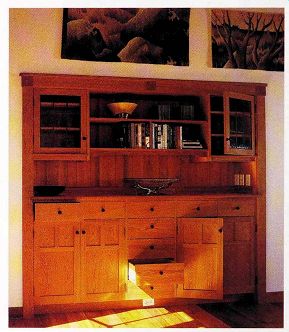
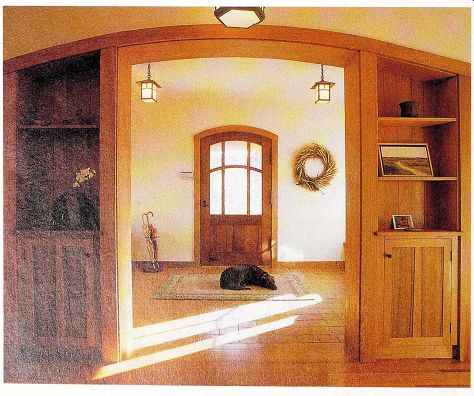
----------- Living-room storage flanks the entry hall, which is guarded
by the family's "watch " dog. A formal, but simple arch ties together
the nicely proportioned composition of open shelves and closed base cabinets.
On the opposite side of the room are wide cabinets, set flush in a thick wall.
The doors on these cabinets have a more complex design than the arched cabinetry
but still complement its general design.
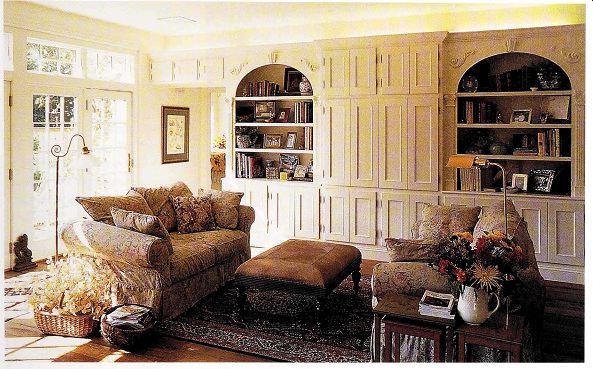
------------- Clerestory windows bounce light off the ceiling above
a deep row of display shelves in this contemporary living room. Other storage
the messy, utilitarian kind-is in sleek, closed cupboards below.
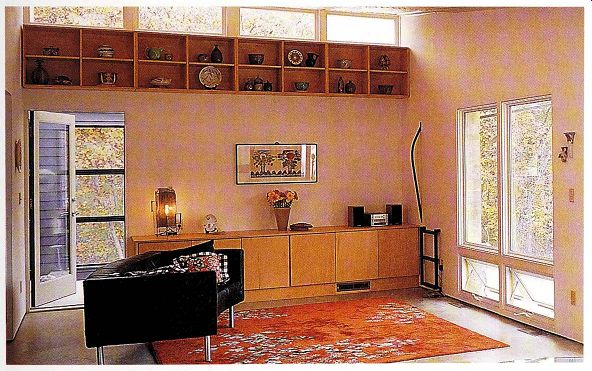
-------------- An impressive wall of built-in storage runs from floor to
9-ft. ceiling, even stretching over a doorway. Closed cabinets are punctuated
by arch-top, open shelves in this peaceful, English-style great room. Crown
molding on the front of the unit runs the length of the wall and conceals fluorescent
light fixtures attached to its top, which suffuse the ceiling with a warm glow
.
Built-in cabinets can be customized to fill small niches for individualized storage, or they can be built on a larger scale to create pseudo-walls that subdivide a room. When you design a bank of built-in cabinets, consider height and depth, complexity of pattern, and a balance of concealed and open storage. A unit that continues to the ceiling will look like part of the wall itself, while stopping it short of the ceiling provides a space for display or lighting. In many cases, base cabinetry alone supplies ample storage , al lowing room for a visual treat above-be it a window, piece of art, OT elaborate mirror.
The upper half of a wall-sized bank of built-in cabinets demands visual attention in a room, and if it's not in balance with the rest of the space, it may look disproportionate and overwhelming. A good way to lighten the effect of a large built-in is to use open shelving or cabinets with glass doors on top, which will also show off your more artful items to best effect. Objects displayed on visible shelves will further benefit from lighting, either within the cabinet or, if it's open shelving, from nearby spot lighting installed on the wall or ceiling.
The lower half of a large-scale built-in traditionally comprises base cabinets fitted with solid doors or drawers, and for good reason. Doors and drawers can be locked or child-proofed if necessary, and they can do the dirty work of masking potential disarray and items that just aren't that good-looking. The contrast between solid lower cabinets and open upper cabinets or shelves can be exploited to good benefit with color, texture , and light, giving a wall of storage (and the rest of the room) visual definition.
Of course, there's no rule that says base cabinets have to be closed while upper cabinets have to be open. Open shelving is less expensive, and for some it's a preference: There's nothing more satisfying to book lovers than shelves of books from floor to ceiling. Conversely, a solid wall of closed cabinetry, such as the beautiful banks of drawers and doors built by Shaker communities, can be a peaceful sight for tired eyes.
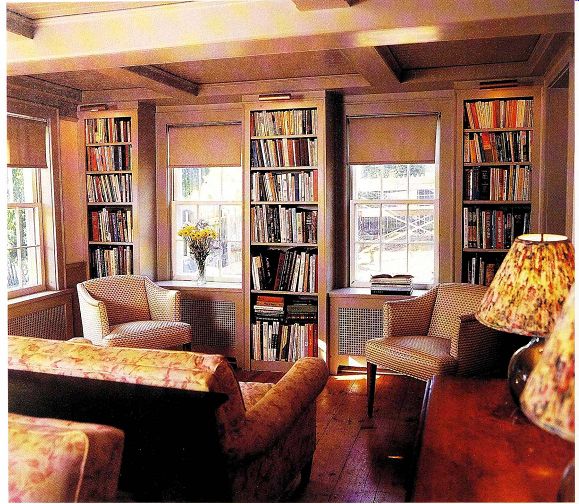
------- The site-built, millwork shelves in this cottage living room are
adjustable to accommodate a growing collection of design books. Cases between
bookshelves cover electric baseboard units and provide extra space to stack
books and display items, such as a vase of daisies .
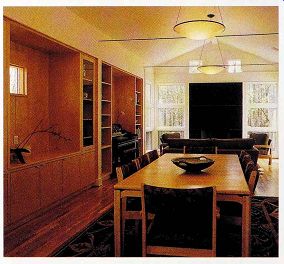
------------ Stretching across the long wall of a modern great room, this
bank of cabinetry is lightened by intervals of open space that create niches
for ikebana (Japanese-style floral arrangements) and a piano.
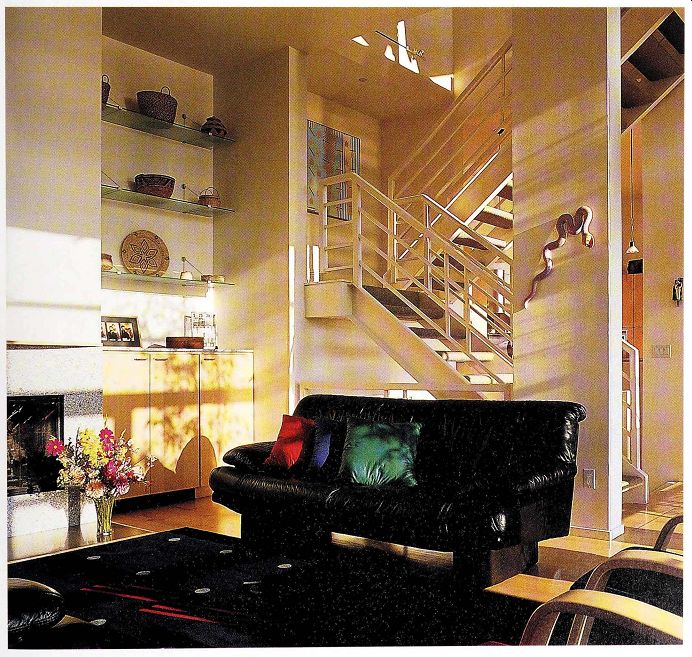
-------------- These glass shelves flank a fi replace in a Seattle living
room. Set into a hillside, the house has no openings on the uphill side, but
large windows on the opposite, eastern side al low sun light to reach the back
wall and shine through the transparent shelves.
==========
Thick Shelves
Thick shelves in wall units have become popular again, thanks to nostalgia for the modern design of the 1950s and ' 60s. The easiest way to achieve this look is by applying an edge band to the front of a thin shelf, but the illusion works only from fa r away.
Another option is to double up layers (3/8 in. thick each) of plywood or medium-density fiberboard (MDF) and finish with an edge band.
However, a far lighter and more stable shelf can be built by layering rows of narrow wood blocks and attaching them to thin plywood panels (top and bottom). Another way to create thick shelves is by copying the construction of a hollow-core door in which a skin of thin plywood or MDF is affixed to a beehive-type inner core-when painted or veneered, the shelves appear to be solid.
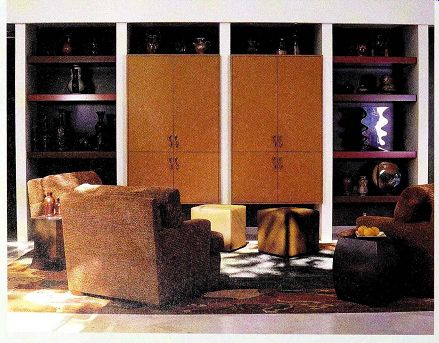
------ This thick, opaque wall in a contemporary glass house is a study
in contrasts. The focus of the wall is a symmetrical arrangement of extra-thick,
open shelves bordering two solid-panel cabinets that appear to float above
the ground. The entertainment center is housed in the closed cabinets.
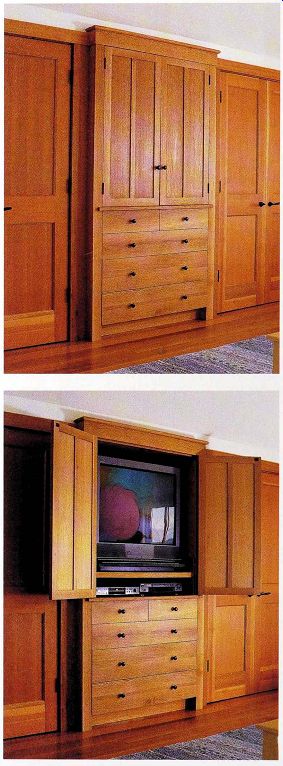
------------ A family living space can't ask for more than what this good-looking,
built- in wall provides.
Drawers, cabinets, and closet space handle a range of items, from extra blankets to games, books, and electronic media. To maintain a traditional look, doors and drawers are inset with black iron hardware.
=====================
Staircase storage

----------- A staircase descending from the living room is lined with
a wall of adjustable shelves, creating cubbies for books in all sizes and shapes,
as well as a point of visual interest.

------------- This great room borrows space from a fat staircase wall
for storing games and other living-space necessities next to the fireplace.
A column of shelves across the hall showcases a collection of cookie jars.
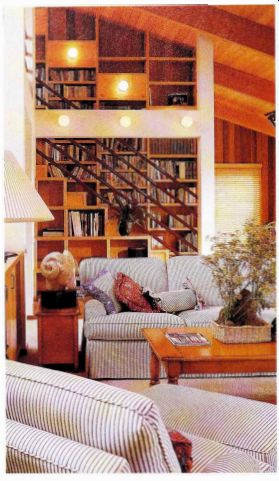
------------- A Both sides of this open stair are faced with bookshelves
that double as display space. Light fixture "boxes" run up the front
side of the stair in between the graduated shelves. An end table is nestled
between couch and cabinet where it's protected from traffic and can safely
hold a sculpture.
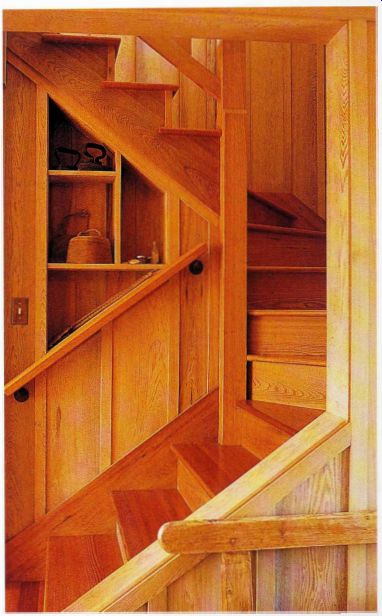
----------------Space between studs in this wood-on-wood staircase makes room
for a collection of small objects that remind the owners of the beach.
If there's a staircase in or adjacent to your living space, it can be the starting point (perhaps with a few modifications) for a built-in storage unit. A stair can be a dramatic focus for storage niches that are either built into the actual structure of the staircase or spun off from landings and railings.
Benches with hinged or sliding lids can be incorporated into the staircase, creating a perfect storage space for bulky items, such as blankets, pillows, and linens, or seasonal clothing and outerwear. Smaller box units can organize and hide board games, video games, and preschooler toys. If room al lows, each family member could have a bin, drawer, or cabinet for miscellaneous stuff. Recessed or projected shelves can be used as a backup bookcase, or they can be used as display areas for photographs or artful collections.
It's important to remember, however, that the stair's primary function is as a pathway to and from other floors, so storage should not disrupt traffic, and potential fire hazards, like old newspapers, should not be stored in or around the staircase.
The Entertainment Center
The prime at traction in many of today's living spaces plays an ambivalent role: We'd like to have our TV and hide it, too. Some of us remember when televisions were freestanding furniture, as was audio equipment, but today's sensibilities generally require that the television and sound system reside behind closed doors when not in use. The home for electronics is often a Single wall of cabinetry that is designated the entertainment center. But as electronics evolve, so do storage options.
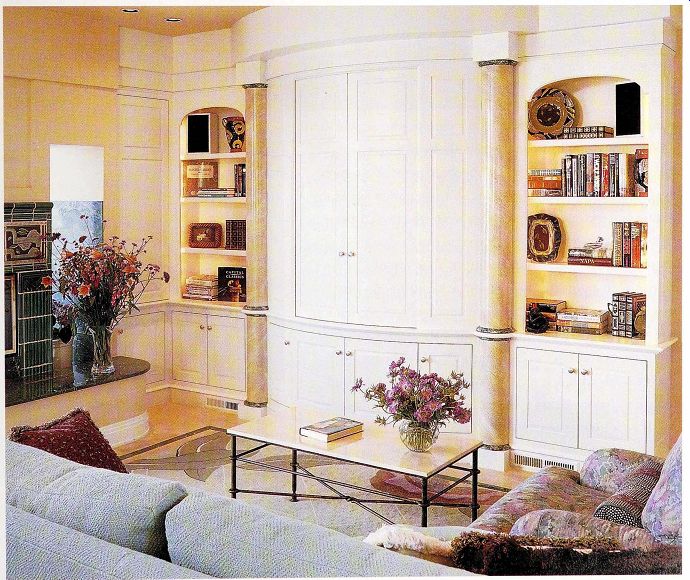
----------- The familiar pattern of open shelving over closed cabinets
flanks a distinctive, curved cabinet that conceals the entertainment center.
Shelves are l it by flexible tube lighting hidden behind the frame. To open, the tall, curved doors slide behind the side panels.
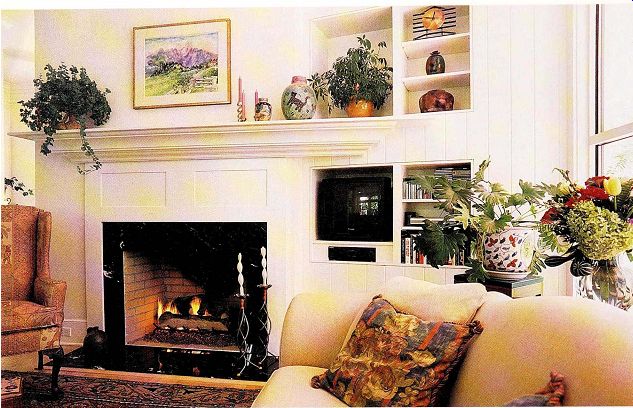
------ This wall with storage niches is angled slightly, making it more
comfortable to watch TV. The angle also separates it slightly from the fi replace,
which creates balance and prevents this busy wall from being overpowering.
The deep mantel molding extends into the angled portion of the wall, however, which makes the transition from fi replace to storage fluid and natural.
The Television
In most cases, the television sits in a closed cabinet, whether freestanding or built-in, outfitted with doors that won't obscure viewing when opened. A more expensive assembly involves hardware that allows the TV to be pulled out of the cabinet and swiveled so that it can be viewed from different angles. For considerable cost, a system can be designed whereby the television ascends through the top of a cabinet by way of an automated scissor- or rack-and-pinion lift; incredibly, these systems can be custom-made to accommodate a television up to 20 ft. wide. And the latest wonder of electronic evolution, the flat-screen TV, fits tight against, or even flush with, the wall. It, too, can be hidden behind doors or a painting that glides out of the way by remote control. If an all-out home theater is in your future, hire a professional consultant to devise and install the storage system; the sensitive (and multitudinous) equipment requires special consideration.
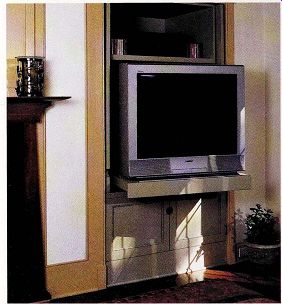
------ This family room stores its television behind flipper doors
that require little clearance inside the cabinet because they have no hardware,
only half-circle finger pulls. The television can slide almost completely out
on a heavy-duty shelf, then swivel to suit various seating arrangements. A
cubby attached to the top of the cabinet provides storage for additional electronic
units, while a bottom cabinet holds tapes, CDs, and DVDs.
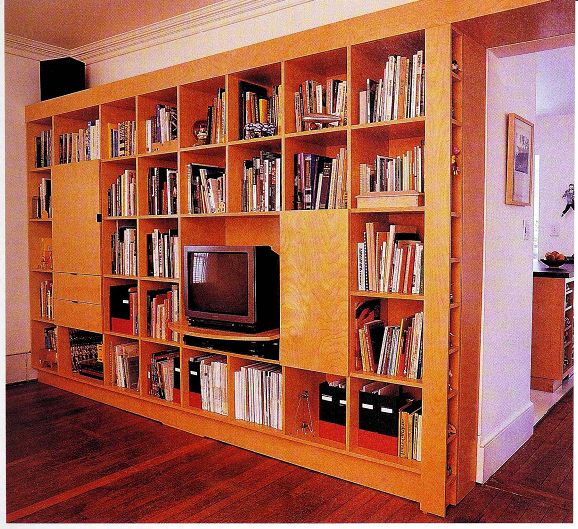
--------- This flat-screen television poses as a framed picture, hanging
over the living room's centerpiece, a Japanese-style freestanding cabinet,
which has plenty of nooks for videotapes and a VCR.
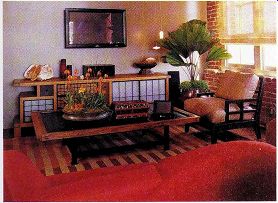
------------ Fixed, open shelves and sol id-panel doors store a lively
mix of media, including books, a television, and a sound system (hidden behind
the door at right). The door at left conceals a collection of videos.
The Sound System
Another component that's good to hear but not necessarily see is audio equipment-call it a sound system, stereo, or hi-fi, depending on your generation. Sound systems have changed in heft and style many times over the years, but it's still the speakers that are the hardest element to store. The cleanest option is to build speakers into a wall or cabinetry; the less expensive option is simply to position them on a shelf. Audio speakers vary in requirements, but generally speaking, it's best to position them equidistant from listeners but not to center them vertically between ceiling and floor.
Home-theater speakers must be placed properly to produce their full effect, so unless you have experience with acoustics, it's best to let an expert set them up. If possible, consult with the expert before you design storage for the system or you may end up backtracking to accommodate its special needs.
============
Measure, Measure, Measure
Proper dimensions are critical when storing electronic equipment in cabinetry. It can't be reiterated enough: Measure equipment before designing or purchasing cabinetry unless you're willing to risk buying a smaller unit than you actually need. Manufacturers' specifications should be accurate, but they frequently don't include wiring run outs where wiring exits a unit and how much it can bend. And since models can change quickly, specs may be outdated.
In an ideal world, electronic equipment will be on hand before cabinetry is designed or purchased. It's important to consider how and where cords attach, and how much extra space will be needed for safe wiring. An electrician may demand--rightfully--as much as 6 in. between the back of the electronic component and the back of the storage unit to handle wiring. It's also important to consider all the existing appendages that must be accommodated, as well as extra space for growing collections and additional components that may be purchased down the road.
Take into account how the storage unit's doors will operate-they may require additional clearance. Flipper doors need room to slide between television and case, and pocket and sliding doors need extra room to clear the front of the television. Certain hardware, like concealed hinges, reduces side clearance.
================
Al l the Accessories
A major task of an entertainment center is to accommodate a supporting cast of multimedia: videotapes, CDs, and DVDs. Fortunately, there's a growing legion of systems customized to store specific types of multimedia. You'll find vertical and horizontal racks, covered boxes, slide-out drawers, and automated storage gadgets as simple or complex as you like. And even if it wasn't specifically designed to do so, any unit with drawers that are at least 5 in. deep can accommodate spine-up CDs or videos (just beware of extra-wide video cases) . The drawer can also be fitted with 5-in.-wide slots, which will further ensure that CDs and videos stay put-assuming everyone cooperates by returning items to their proper slots. Remember to designate a specific spot--be it a drawer, nook, or slot-for remote-control devices near the appropriate equipment, or store them in a basket or other container next to seating areas.
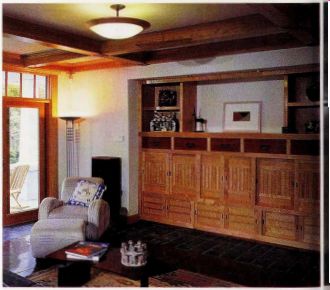
-------- This Japanese-inspired cabinetry not only handles the television
and sound system-aside from the giant speakers-it also offers plenty of options
for accessory storage in drawers or bottom cupboards.
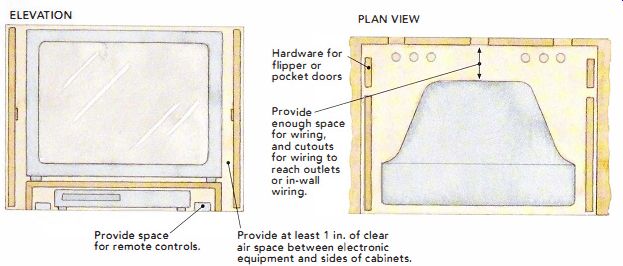
--------- Tips for Storing Electronics
In the case of flipper doors, shelving for electronic equipment can be attached to bottom or top shelf.
Ventilation:
• In built-in cabinetry, provide cutouts in shelves and out the top or sides of cabinet to create a chimney effect.
• In freestanding cabinetry, provide cutouts in back of cabinetry.
ELEVATION -- PLAN VIEW
Provide space for remote controls.
Hardware for flipper or pocket doors Provide enough space for wiring, and cutouts for wiring to reach outlets or in-wall wiring.
Provide at least 1 in. of clear air space between electronic equipment and sides of cabinets.
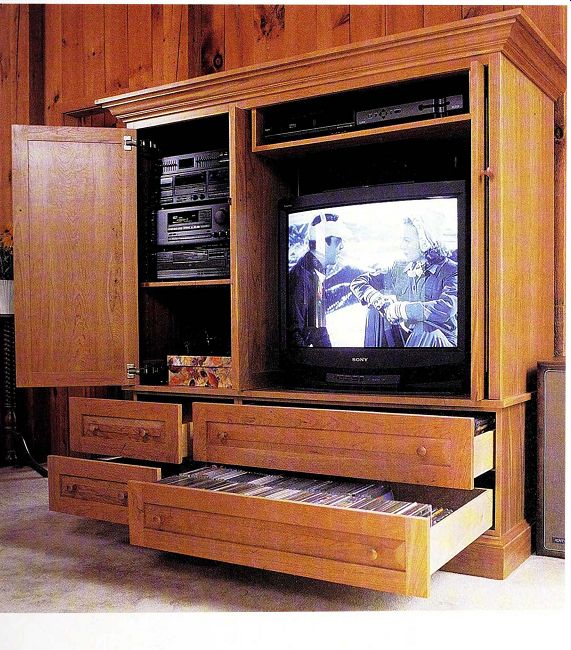
----------- This entertainment center was designed and built by a seasoned
cabinetmaker who has constructed many such assemblies. His recommended details
include pocket doors that slide inside the cabinet, a hanging shelf for VCR,
sufficient space on the side for a sound system, and drawers for CDs and videotapes
.
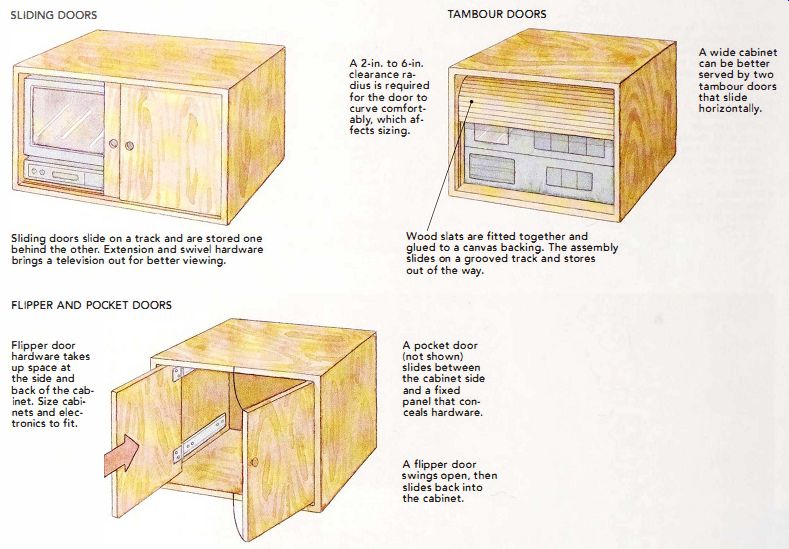
----------- Options for Entertainment-Center Doors
SLIDING DOORS
A 2-in. to 6-in. clearance radius is required for the door to curve comfortably, which affects sizing.
TAMBOUR DOORS
Sliding doors slide on a track and are stored one behind the other. Extension and swivel hardware brings a television out for better viewing.
Wood slats are fitted together and glued to a canvas backing. The assembly slides on a grooved track and stores out of the way.
FLIPPER AND POCKET DOORS
Flipper door hardware takes up space at the side and back of the cabinet. Size cabinets and electronics to fit.
A pocket door (not shown) slides between the cabinet side and a fixed panel that conceals hardware.
A flipper door swings open, then slides back into the cabinet.
A wide cabinet can be better served by two tambour doors that slide horizontally.
---------------
Options for Entertainment Center Doors
Swinging doors are the standard on cabinets, but there are other types of doors to consider for entertainment centers.
Sliding doors have been a rarity since the 1960s, but with modern design back in vogue, we're seeing more of them again. They're ideal for concealing televisions in more traditional-style cabinets, too. Sliding doors require no clearance in front of the cabinet (you won't bang your head on them), but they also don't allow the entire cabinet to be viewed, so television size should be planned accordingly.
Flipper and pocket doors swing open just like a swinging door, but then they slide into the cabinet along the sides (overhead flipper doors are available, too). A pocket door slides between the cabinet case and a panel that hides the sliding mechanism and provides a surface for supporting shelves (see the drawing on the facing page). A flipper door slides back and hides the hardware, but it can't support shelves, of course. Ideally, each type of door retracts completely into the cabinet (the handle has to fit inside the cabinet, too) so that the doors don't obscure your view of the television inside. Be aware that flipper and pocket doors require extra depth and width to handle the hardware and the door. The pocket door takes up more space because of the extra side panel.
Tambour doors are made up of thin strips of material that slide up and out of the way on a track. They do take up space at the top of the cabinet, both for the door and the curved track, so it's necessary to allow extra clearance when sizing electronic equipment.
-----------
Breathing Room
While today's electronics don't have vacuum tubes, which were notorious for high temperatures, they still give off heat.
If not properly ventilated, the heat can burn out electronic equipment prematurely. A built-in entertainment center should include enough clearance around the television or sound system for heat to dissipate, and a freestanding unit should have space behind it for ventilation.
An electronics expert can provide valuable advice for your specific system.
-----------
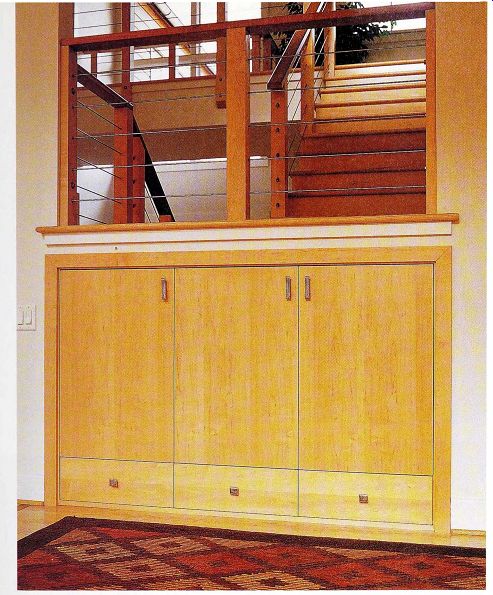
------------- A stair landing provides an ideal, if unusual, space for
a small entertainment center.
This frameless cabinet with flipper doors houses a television and an audio system, while the drawers below hold videos, DVDs, and CDs.
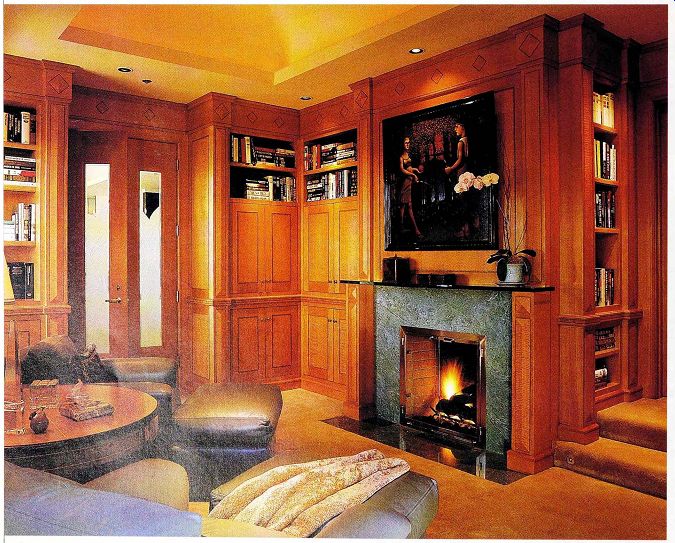
----------- This sitting room is made comfortable and peaceful by a fireplace
that anchors a wealth of built-in storage. The walls of rich cherry cabinetry
conceal electronic equipment, while open shelves show off an elegant book collection
to best advantage-no paperback novels here.
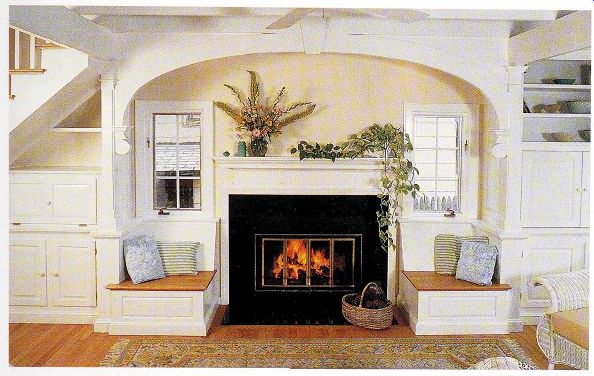
--------------- An Arts and Crafts fireplace mantel provides storage/display
space for a favorite collection.
The stone hearth holds antique tools and a basket for kindling storage. The intricate, paint grade trim fireplace details were rendered from poplar frames and medium-density fiberboard panels.
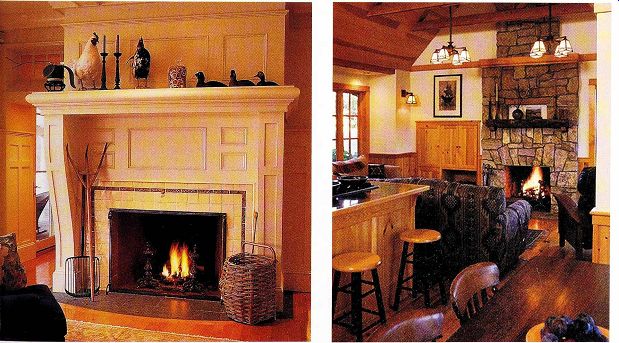
---------- An inglenook with built-in seating and storage cabinetry
makes a cozy focus for a living room.
-------- This sitting area is part of a great room that includes dining and kitchen areas.
A fi replace with rustic wood mantel is flan ked by a recess for firewood and cupboards for games and such.
Fireplaces
Fireplaces have been the focus of living spaces for thousands of years (in fact, focus is Latin for fireplace) , but even in today's more elaborate rooms, they still make an ideal focal point, exuding warmth and comfort.
Fireplaces frequently incorporate storage space for firewood, whether in a built-in niche or a movable log rack, which adds a homey ambience, but it can feature storage for other items, too. Fireplace tools are a natural addition, and the fireplace can even provide a structure for built-ins.
Lidded-boxes can be installed on either side of the hearth or a bank of cabinets can become an extension of the mantel.
The mantel is a favored spot for displaying treasured possessions and art. We put things on our mantels without a second thought-photos, candlesticks, art, and pottery-but consideration should be given to this potentially hot and sooty environment if the fireplace is used frequently. A fine painting or photograph can be damaged if habitually exposed to heat.
Showcasing Art and Treasures

----------- There's no space untouched by art in this Mexican-inspired
house, from floor to ceiling, table to mantel. Even the architecture i s art,
with color and geometry balanced by sculpture, painting, and artifacts. Decorative
objects are stored on ledges around the fi replace and on shelves in a range
of shapes, sizes, and materials. Closed storage is provided by streamlined
cabinets in a variety of harmoniously contrasting woods.

-------- This room proves that storage doesn't have to be formal to be
visually appealing and functional. Here, three bold rows of storage and display
are created, beginning with the plate rail, descending to the wainscoting rail,
and landing on the floor where art and book stacks lean against the wall. This
casual but carefully assembled arrangement lends an intimate, personal feel
to this living space without suggesting clutter or chaos.
-------------
==========
Lighting Art and Collections
Properly lighting collections is almost as important as choosing the proper display area for them. Downlights that are recessed into the ceiling or a soffit can handle several tasks. Adjustable fixtures can highlight art or be used for reading, while wall washers can be used to cast an ambient light on shelves and walls. Displays can also be lit with under-shelf, low-voltage puck lighting or with strings of incandescent bulbs, which are hidden along the top or sides of a cabinet opening. Under-shelf lighting should be positioned close to the front of the shelf, which conceals the fixture and allows light to fall on the front of highlighted objects. Side lighting is ideal for glassware and collections of arts and crafts.
=========
In a living space, storage plays a supporting role to aesthetics. Much of what you're storing is items that have no other purpose than beauty, and they need a protected but well-lit space where they can shine. Storage spaces as small as a wall sconce and as large as an entire wall can showcase objects in the manner that suits them best.
When planning the arrangement of artful items, it's important to remember that a living space needs a focal point to give the room an anchor; what that anchor is depends on personal preference, style, and habits. For avid art collectors, a prominently displayed painting gives a living space personality while reflecting that of the inhabitants. In more casual settings, an attractively housed television makes a practical and perfectly appropriate focal point.
Whatever you choose to display and no matter how you choose to display it, the important thing is to make sure that it brings you joy and makes your home a happier place to live in.
Storage as Sculpture
In many cases, the furniture that displays art can be a work of art in its own right.
For instance, an antique cabinet, custom made shelves, or niches recessed into a thick wall can become part of the display themselves, sometimes stealing the show.
If that doesn't suit your style, just be sure to match the quality of the display with the storage piece, so that each balances and complements the other.
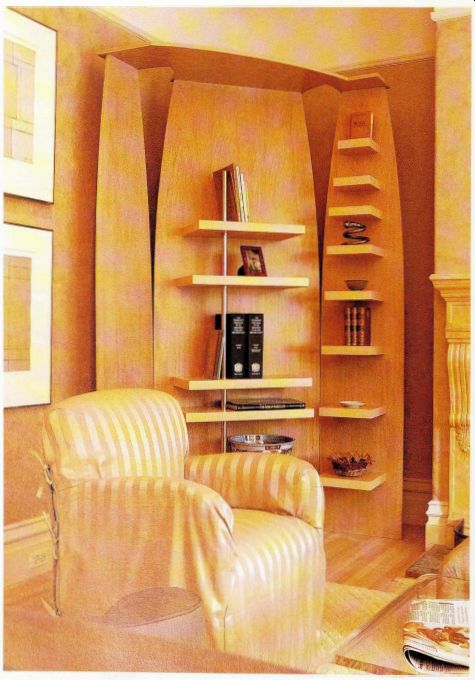
--------- These alcoves turn the entire wall into a work of art within
which dwell smaller pieces of folk art from around the world.

------- These cantilevered shelves create a minimalist's storage system.
======
Keeping Breakables Secure
Residents of earthquake-prone areas aren't the only ones who should take extra measures to secure valuable art, collections, and even electronic equipment.
A household with kids or pets, an apartment in the city, or a house near an active railroad or airport will also benefit from actively securing breakables. Secure large pieces of art and electronics with straps; secure smaller pieces to shelves with a substance called earthquake putty, or museum wax, an inexpensive substance that can be removed and reused. It comes in putty form or in a clear gel that's appropriate for glass shelves. Shelves can also be covered with rubber shelf liners to keep items from slipping.
======
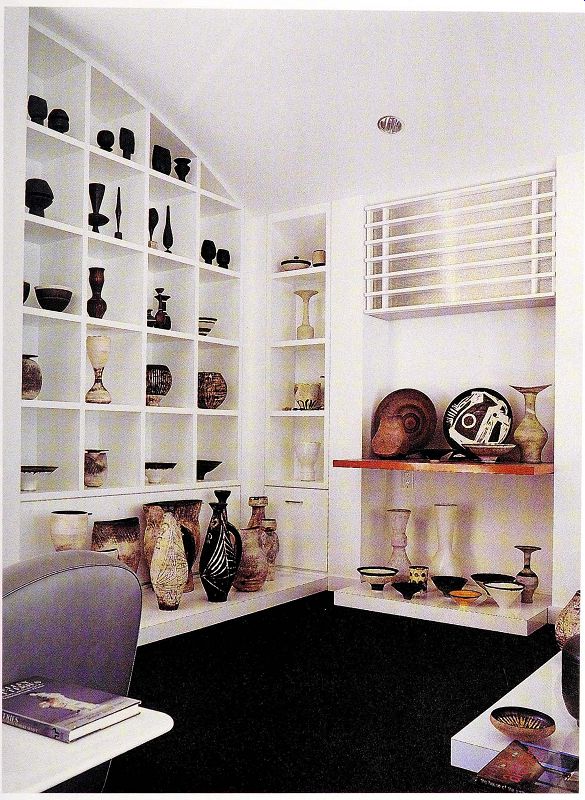
------- In this sitting loft, which perches over the living room, a stunning
collection of pottery is displayed in specially designed niches.